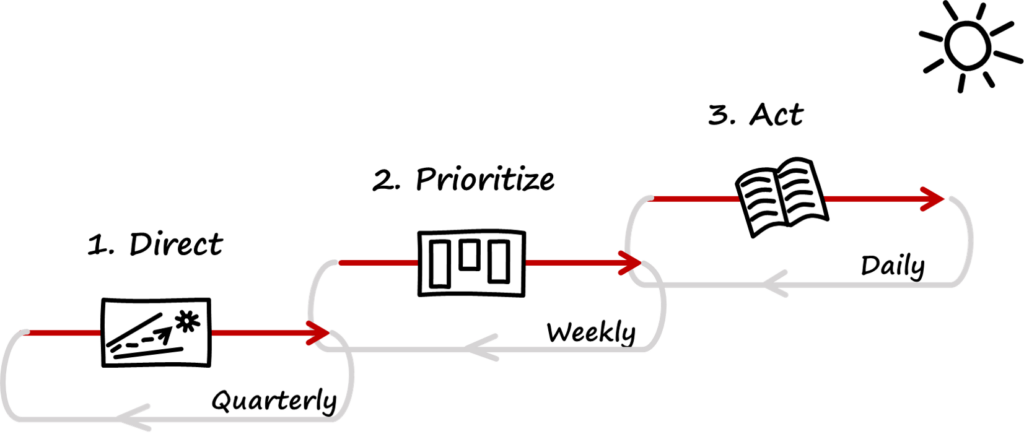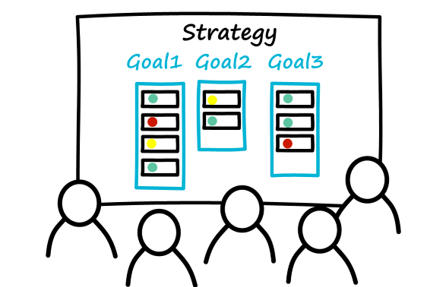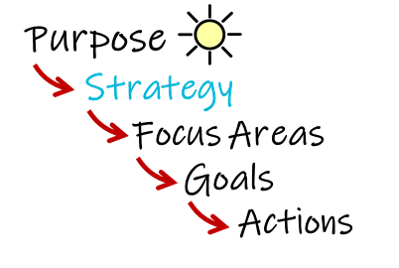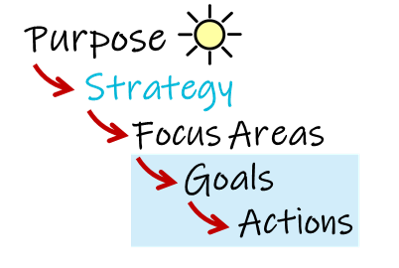
The presence of strategy in daily work — 3.01
Markus Westerlund
Share this blog
Many organizations experience problems with the strategy becoming present in everyday business. You see, when you create the strategy, it easily remains hidden somewhere out of sight, and nobody looks at it until the next time the strategy is updated. A present strategy is what you need.
Three loops

This is an image of three loops from the strategy journey.
Here is, once again, our strategy model with three loops. In the first loop, we direct the company and find a direction we think will bring us success. In the second loop, we start steering the strategy implementation. Big goals get broken down into subgoals, which the management prioritizes. When goals are defined, we proceed to loop three, everyday operative work.
The link connecting the first and second loop often breaks. It’s one of the reasons why organizations fail to implement their strategy. If you want to ignite your company’s strategy, make the loops rotate and keep them linked.
Summarizing everything on a single page

The key with creating a Strategy 1Pager is to summarize everything to a single page.
The strategy crystallizes from many ideas. The unique thing about our work process is that we hold strategy meetings with the whole staff, where everyone is allowed to give comments. Meetings take place at the beginning, the middle, and the end of the strategy process. Workshops occur with expanded group composition.
A significant number of ideas are gathered, refined, and prioritized. In the end, the strategy gets crystallized onto a single page, Strategy 1Pager. Then the implementation process begins.
Strategy 1Pager

Meetings, meetings...

Several meetings take place in companies. The question is, is the strategy present in the meeting agendas? Unfortunately, I suspect that it is not actively present in that many meetings.
Operative tasks eat up the time
Operative matters quickly eat up all the time that people have reserved for thinking about the strategy. In another blog, I told you that important and urgent issues compete against each other. In this competition, urgent matters always win.
The talent is to have the strategic goals present during the meetings. How is it done in practice? There are better and worse solutions to that; however, I’ll explain one excellent approach and a new possibility for you.
How you lead and follow up progress

Use a digital board. Track progress through it.
Let’s move the strategy onto a digital board! Everybody can see the whole strategy and write comments onto cards, which get grouped according to goals. When your big goals are present on the board and separated into specific tasks, traffic lights show how strategy implementation progresses.
When the essential tasks are listed, staff can notice that one or several goals may no longer be optimal. Goals and tasks can influence each other, which creates an interesting dynamic. This dynamic between goals and tasks is a component of agile leadership, a living strategy. Staff can also notice quite fast if the goals have been completed. Once complete, the team can fill the void with new the following objectives.
The point is in how people lead themselves and follow up on the work. Is the work in sync with the strategy? When we have a digital board, it affects our work. The media is the message! When the board makes the things we pursue visible for us, we go towards our goals much more efficiently. This way the strategy becomes present.
The Purpose

Every business needs to have a Purpose, the sun, for it to exist. Some have written it down; others have not. The purpose is not only about earning money for the shareholders – even though it is essential. But we make more when the purpose is an answer to what you do for our customers.
If you involve the customer in this purpose, you suddenly earn more money for the shareholders. You get better success because you think outside-in instead of pushing out products from an inside-out perspective. That’s why the purpose must be visible on the strategy page.
A strategy implements the purpose. It helps you to implement it more efficiently for your customers. In the end, the strategy can be just a few sentences long—an elevator pitch.
The strategy consists of focus areas. What are the areas that need focus? These focus areas are written down clearly in the strategy. The next thing is identifying the big goals. There can’t be too many focus areas; three or four is often the right amount. Otherwise, your attention gets split on too many things, and nothing gets finished in time.
To reiterate the marmalade phenomenon: Every organization has a spoonful of marmalade and a certain number of toasts to butter. The management can’t pick too many toast pieces; otherwise, you won’t taste the marmalade.
In a large corporation, two focus areas can be too few, but five can be too many. In a smaller company, two or even one focus area can be enough. If a storm erupts, focus areas need prioritization. The company reduces the number of things receiving focus. In that situation, a big company might have only two focus areas. Storms can come from black swan events (unexpected events), like a global pandemic.
Goals and targets

It’s very vital that your company has a way to prioritize things, a hierarchy if you will.
It isn’t easy to implement a strategy if one merely goes with the flow and invents goals out of thin air. When the whole staff is involved in the strategy process, critical operative thinking always happens. The strategy and the focus areas get seen as high-quality ideas.
Without a satellite perspective, the ideas according to which the company operates lack sufficient perspective, in my opinion.
If you don’t understand your purpose for the customers, you don’t necessarily focus your energy on the most important things. If you only think about operative goals and tasks, you’re arranging deck chairs on the Titanic a few moments before the ship hits the iceberg. You also have to examine the road into the future.
Helicopter perspective
During the five-day war in Kuwait, general Schwarzkopf held daily press conferences. He said that it’s possible to make good decisions from the grassroots perspective; however, when one rises to the helicopter level, “then you know what to do.”
We can use Schwartzkopf’s approach as a good example. An organization, with a clear upper-level view, defines better goals for itself. Even in a one-person micro-enterprise, it’s beneficial to understand what should receive focus!
In smaller companies, the focus areas might often change, even every couple of months. The implementation of the focus areas takes longer in larger companies. They complete more comprehensive strategy rounds now and then. After that, it’s perfectly acceptable to look at the strategy quarterly. How is it doing, and has it progressed?
Safe stability is gone
These days companies need people to think about the most critical topics more frequently and faster. To those who believe that their industry isn’t changing rapidly, I say good luck. I’m afraid the time of safe stability is gone. One of the few safe things a company can do is stay constantly alert and sense what customers need. React immediately to sudden changes.
Following the big picture: trends and competition, etc.
The company staff must follow up the strategy implementation constantly.
You need continuous follow-up
A series of meetings is called a management system. The management system provides answers to various questions. What kind of meetings? What are the themes and mission of each session? How often are meetings held? What is the meeting agenda? What are things measured during the meeting?
Take a look at your management system and follow up on implementation progression progress now and then. During bad times if you don’t reach the goals, the management system meetings are held more frequently. A loose follow-up can lead to an inefficient way of working. Inefficiency can cause you not to reach the goals you’ve set out for yourself. That’s why it’s imperative to lead the strategy through the organization.
Leadership inside the organization

Look at the above image. Let’s pretend the management group is in the middle. It follows up on upper-level goals, but, in the meantime, every team in the organization has also interpreted what those high-level goals mean to them personally.
Now comes the trick. Everyone can, and should, have access to a digital board of their own, which links to the other boards through an internal logic. The goals and tasks are easily made visible on the board. Through this approach, the company ensures that the upper-level goals are, within reason, broken down into subgoals.
Some time ago, I was facilitating the strategy creation process in a large corporation. The process took place over multiple days. On the second day, the idea was to set goals for the fourth quarter, but suddenly the conversation changed the process agenda and gave birth to a new Strategy 1Pager. And that’s what we did. The strategy didn’t change, but we noticed the focus areas needed to be updated.
Bottom up!
Together we defined the new big focus areas and created everything from the bottom up. We browsed through the essential topics. The most critical matters passed the filter. As a result, the Strategy 1Pager contents changed. In retrospect, a person could think we made an extensive strategy round, but we only ended up changing the focus areas.
Even though the corporation in question is a billion-dollar company, it’s beginning to be quite agile. Agility has developed over several years. Decisions aren’t carved in stone. When we modified the 1Pager, we merely documented the new situation! It was a surprise to everyone; it wasn’t the plan to even make a new one-page strategy. The strategy stayed the same even if the focus areas changed.
Every team has a separate function. The important thing is how the teams begin to implement them.
Today's point: Continuous Prioritization

The point of the day is constantly prioritizing by using a digital board. Strategy becomes present in everyday life—staff sails within the sector defined by the chosen strategy. Every day staff senses from which direction the wind blows. Sensing like this enables everyone to act with agility.
The Purpose gives the staff and customers energy. People get inspired when actions align with the purpose. The team goes along because everybody works towards a great thing. A great purpose means customers get help. Customers are thrilled when they can access the expertise they need.
If you want the strategy to be present in your everyday life, you must prioritize constantly. The strategy must be part of the meeting agenda in the weekly meetings! It may sound overwhelming, but it’s not. You only need one board, in which the strategy is visible all the time!
Do this correctly, and your strategy will become present and steer your daily activities!
Ignite your strategy! Read more.🔥
Recent Posts
Stradigo
Stradigo is a brand owned by Rdigo Oy (Business-ID: 2120844-1).
Learn more from our Imprint.
Rdigo Oy is registered in Finland as a Limited company. We are a strategy consultancy located in the Helsinki capital region.
We’ve been in business since 2007. The company name comes from the latin word Redigo, meaning both ‘I shape’ & ‘I renew’.
Stradigo combines the word strategy with Rdigo.